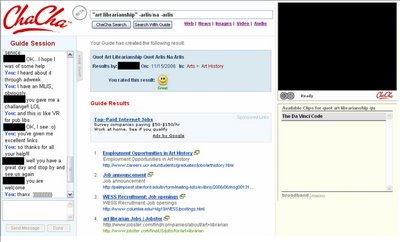Cha Cha's edge comes from guided searches where the user partners with an actual human. Cha Cha calls them Guides, and they are described as people who are “skilled at finding information on the internet and knowledgable [sic] on the subject at hand.” Hmm…hopefully more so than Cha Cha’s editor. (I’ve notified Cha Cha about their little faux pas).
Cha Cha claims that users who partner with a Guide “get the few exact results you want, not the millions of results you don't.” So, I decided to take them up on the challenge.
When you first go to Cha Cha’s site, you are greeted with Cha Cha’s logo (which loosely resembles Coca-Cola’s), a search box with two choices (“Cha Cha Search” or “Search with Guide”), and a horizontal bar (composed of hundreds of itty-bitty thumbnails), and various details about the Cha Cha project.
The composition is neatly laid out with a strong & centralized vertical column that is accented by the bold horizontal bar. Effectively dividing the search area from Cha Cha’s metadata, the horizontal bar rest towards the bottom of the page—which also helps anchor it. Little color is used, and the pristine whiteness of the page is only offset by Cha Cha’s logo and the horizontal bar.
I chose to query “art librarianship” without results pertaining to ARLIS/NA or ARLIS. Users may use natural language when querying because a Guide will field the question (I love that). However, for me, I chose a more mechanical notation (e.g. “art librarianship” –ARLIS/NA –ARLIS). Then, I selected the “Search with Guide” button.
A second page appeared, and, within seconds, I was chatting with my Guide using a built in instant messaging (IM) system. My Guide began the reference interview by drilling down to see if I was interested in any particular areas within art librarianship.
At this point, the interview was fairly neutral. Personally, I just wanted any information that pertained to art librarianship that was outside of ARLIS/NA or ARLIS (UK/IRELAND). Interestingly, the Guide used a closed-ended question, and they asked if I was interested in jobs within the field. That sounded good (even though my interest in the subject was much broader), and we went from there.
I told the guide I already knew about ALA’s Joblist and ARLIS/NA’s postings so that we could forgo what I already knew (the guide did not ask if I had already conducted some research). The Guide did ask if I preferred any geographical areas, and I replied that I was open to positions nationally or internationally. The Guide then proceeded to find four sites that used the word Job or Employment and “Art Librar*” (See the picture below).
The first page was probably culled because it had ARLIS/NA’s job postings. The second page was retrieved because it was a job posting for an art & architecture library that was posted in a listserv. The third was recovered because it also listed a position for an architecture and art librarian. The final page was retrieved because Jobster uses algorithms that partner with the users query to provide meaningful results (or so they would say – there were more law library position listed in the 1st page than art library positions).
At this point, I ended the search with the guide. It was not because I was dissatisfied with the results (I had yet to critique them). Instead, I had spent about 5 minutes conversing with a very affable Cha Cha Guide, and I was ready to move on.
After our search ended and the Guide logged off, I felt very good about the transaction. However, after analyzing the transaction, I realized I was led more than I wanted to be during reference interview, and I soon came to the conclusion that the Guide’s results were not particularly helpful (I already knew about ARLIS/NA’s job list, the second and third retrievals were too old to be relevant, and I already commented on Jobster).
However, to be fair, the job market for art librarians is very limited. So, it was a difficult path for the Guide to take. Maybe the Guide should have asked about or researched for other organizations (e.g. VRL, CAA, etc.)? Also, to be fair, I’ve had mixed results using Ohio’s Know-It-Know 24/7 virtual reference. Although, when I think about it, the folks at KIK 24/7 seemed to have a better grasp of the reference interview.
So, what’s the end result? Cha Cha does cut the clutter from going solo on Google, Yahoo!, etc. Their Web design is simple and straight forward (unlike the redesigned Yahoo!). And, from my experience, I’m guessing their Guides are friendly and personable.
However, Cha Cha’s success rate may mirror the reference librarians’ supposed 50% accuracy rate (See: Terence Crowley and Thomas Childers, Information Service in Public Libraries: Two Studies (Metuchen, N.J.: Scarecrow, 1971). Plus, the service is supported through advertising. Possible conflicts of interest or just the annoyance of advertising may cool some users. On the other hand, do we have a national virtual reference service?









